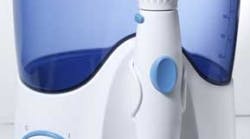By Carol A. Jahn, RDH, MS
New research has demonstrated that the oral irrigator (aka dental water jet , water flosser) reduces bleeding and gingivitis better than floss. Three studies utilizing three different tips have demonstrated this effect. (1,2,3)A 2011 study found that that both the jet tip and a new tip configuration with three thin tufts of soft bristles were significantly better than floss at reducing bleeding at two and four weeks. Notably, at two weeks, the jet tip was twice as effective as floss. At four weeks, gingival bleeding had returned to baseline levels for floss while the irrigation groups continued to show significant improvement. There were no differences in biofilm removal between irrigation and floss.(1)
New research has demonstrated that the oral irrigator (aka dental water jet , water flosser) reduces bleeding and gingivitis better than floss. Three studies utilizing three different tips have demonstrated this effect. (1,2,3)A 2011 study found that that both the jet tip and a new tip configuration with three thin tufts of soft bristles were significantly better than floss at reducing bleeding at two and four weeks. Notably, at two weeks, the jet tip was twice as effective as floss. At four weeks, gingival bleeding had returned to baseline levels for floss while the irrigation groups continued to show significant improvement. There were no differences in biofilm removal between irrigation and floss.(1)
This study confirms results from Barnes et al, who found that irrigation was up to 93% better at reducing bleeding and up to 52% better at reducing gingivitis than floss. This study used the jet tip paired with either a manual or sonic toothbrush and compared them to a manual toothbrush and floss. Importantly, even the group that used the sonic toothbrush improved bleeding and gingivitis scores with irrigation. The irrigation groups were as effective as the manual group at biofilm removal.(2)The third study tested a new orthodontic tip with a tapered brush on adolescents aged 11-17 with full orthodontic appliances and compared it to a manual toothbrush and floss and a manual toothbrush only. At four weeks, the orthodontic tip removed three times as much biofilm as brushing and flossing and five times as much as brushing alone. Irrigation also reduced bleeding more effectively than the other two groups; 26% better than the brushing and flossing group and 53% better than brushing alone.(3) Oral irrigation has a well-established track record for reducing bleeding and gingivitis.(4) Its ability to remove biofilm was demonstrated in a study using scanning electron microscopy. Eight periodontally involved teeth were extracted, sliced, and inoculated with saliva to ensure all teeth were colonized by a luxuriant biofilm growth several millimeters thick. The teeth were subjected to a three-second treatment at medium setting (70 psi) with either the jet tip or the orthodontic tip. Scanning electron micrographs of the teeth demonstrated that the treated areas with either tip had 99% biofilm removal. The investigators concluded that the forces produced by a water flosser with 1,200 pulsations at a 70 psi can significantly remove biofilm from tooth surfaces.(5)To view a video of an oral irrigator in action, go to community.pennwelldentalgroup.com/video/plaqueseeker-1.References
1. Rosema NAM et al. The effect of different interdental cleaning devices on gingival bleeding. J Int Acad Periodontol 2011; 13:2-10.2. Barnes CM et al. Comparison of irrigation to floss as an adjunct to toothbrushing: Effect on bleeding, gingivitis, and supragingival plaque. J Clin Dent 2005; 16:71-77.3. Sharma NC et al. The effect of a dental water jet with orthodontic tip on plaque and bleeding in adolescent orthodontic patients with fixed appliances. Am J Ortho Dentofacial Orthop 2008; 133:565-571.4. Jahn CA. The dental water jet: A historical review of the literature. J Dent Hyg 2010; 84:122-128.5. Gorur A. Biofilm removal with a dental water jet. Compend Contin Ed Dent 2009; 30(Suppl):1-6.
1. Rosema NAM et al. The effect of different interdental cleaning devices on gingival bleeding. J Int Acad Periodontol 2011; 13:2-10.2. Barnes CM et al. Comparison of irrigation to floss as an adjunct to toothbrushing: Effect on bleeding, gingivitis, and supragingival plaque. J Clin Dent 2005; 16:71-77.3. Sharma NC et al. The effect of a dental water jet with orthodontic tip on plaque and bleeding in adolescent orthodontic patients with fixed appliances. Am J Ortho Dentofacial Orthop 2008; 133:565-571.4. Jahn CA. The dental water jet: A historical review of the literature. J Dent Hyg 2010; 84:122-128.5. Gorur A. Biofilm removal with a dental water jet. Compend Contin Ed Dent 2009; 30(Suppl):1-6.
Carol A. Jahn, RDH, MS is the Senior Professional Relations Manager for Water Pik, Inc. She can be reached at [email protected].








